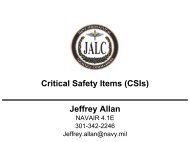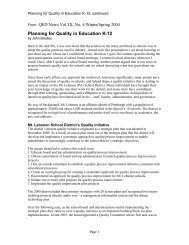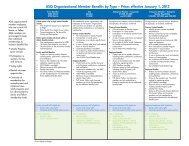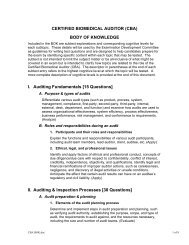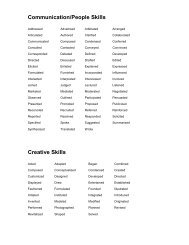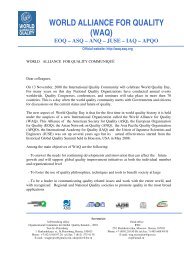Quality Progress - American Society for Quality
Quality Progress - American Society for Quality
Quality Progress - American Society for Quality
Create successful ePaper yourself
Turn your PDF publications into a flip-book with our unique Google optimized e-Paper software.
feel com<strong>for</strong>table that they can express their view, including disagreement with the VP's<br />
when appropriate, you will start to see progress. If they work in an atmosphere where<br />
upper management is comprised of a bunch of pig headed executives who care about<br />
nothing but their bonus, you might as well not even attempt process improvement at any<br />
level. They will not listen. You get a group of Directors and VP's together to make a<br />
process improvement and all you are going to end up with is ego, smoke and mirrors and<br />
cost cutting. "This goes against the basics of Six Sigma." ??? I have yet to see proof that<br />
six sigma ever improved any process. Some of the tools are there, un<strong>for</strong>tunately the<br />
process is hung up on "cooking up" numbers to justify the cost of the training and<br />
initiating the project in the first place. In any case, as with any article, or book, not every<br />
point will apply to all companies. You have to separate what will work <strong>for</strong> your<br />
company at a particular point in time.<br />
Just my 2 cents.<br />
Regards,<br />
Carl W. Keller<br />
ASQ Certified <strong>Quality</strong> Manager<br />
16935 Letter: Process Management Article En<strong>for</strong>ces Bad Advice<br />
ASQ Staff<br />
Sep-08-03<br />
I was disappointed in Tom Dolan's article "Best Practices in Process Management"<br />
(August 2003, p. 23). In part because it had very little new to say, but more so because it<br />
served to pass along some bad, very common, advice. There are too many to address in a<br />
short letter; they ranged from small to large. A couple worth mentioning: 1. Of the 10<br />
processes identified on p. 25, only three (maybe four) are processes, the remainder were<br />
departments or programs. HR, accounting or customer service and satisfaction are not<br />
processes, no matter how many times the thousands of members from the Benchmarking<br />
Exchange might have mistakenly thought they were. 2. A process improvement team<br />
made up of representatives from all functional groups, all customers, all stakeholders will<br />
sink under its own weight. It sounds nice but has a variety of flaws: * Customer needs<br />
and requirements are best represented with accurate, reliable data and then followed up<br />
with focus groups or focused work groups. Customer representatives on teams expect to<br />
be listened to - even if they don't represent all of your customers. This goes against the<br />
basics of Six Sigma. * Mixing employees and managers on a team will not bring out the<br />
best in either. Contexts of knowledge and priorities will be too diverse. It may sound like<br />
a good idea but will bog a team down. Team membership should be based on expertise<br />
on the process, as it is, as it must become and what is required to get it there (if that is<br />
already decided). It may sound undemocratic, but then process improvment isn't<br />
necessarily a voting issue - geting results is what counts. I look to <strong>Quality</strong> <strong>Progress</strong> <strong>for</strong><br />
good ideas. This aritcle was way below your standards.<br />
David N. Williams<br />
davidw@williamsalliance.com




